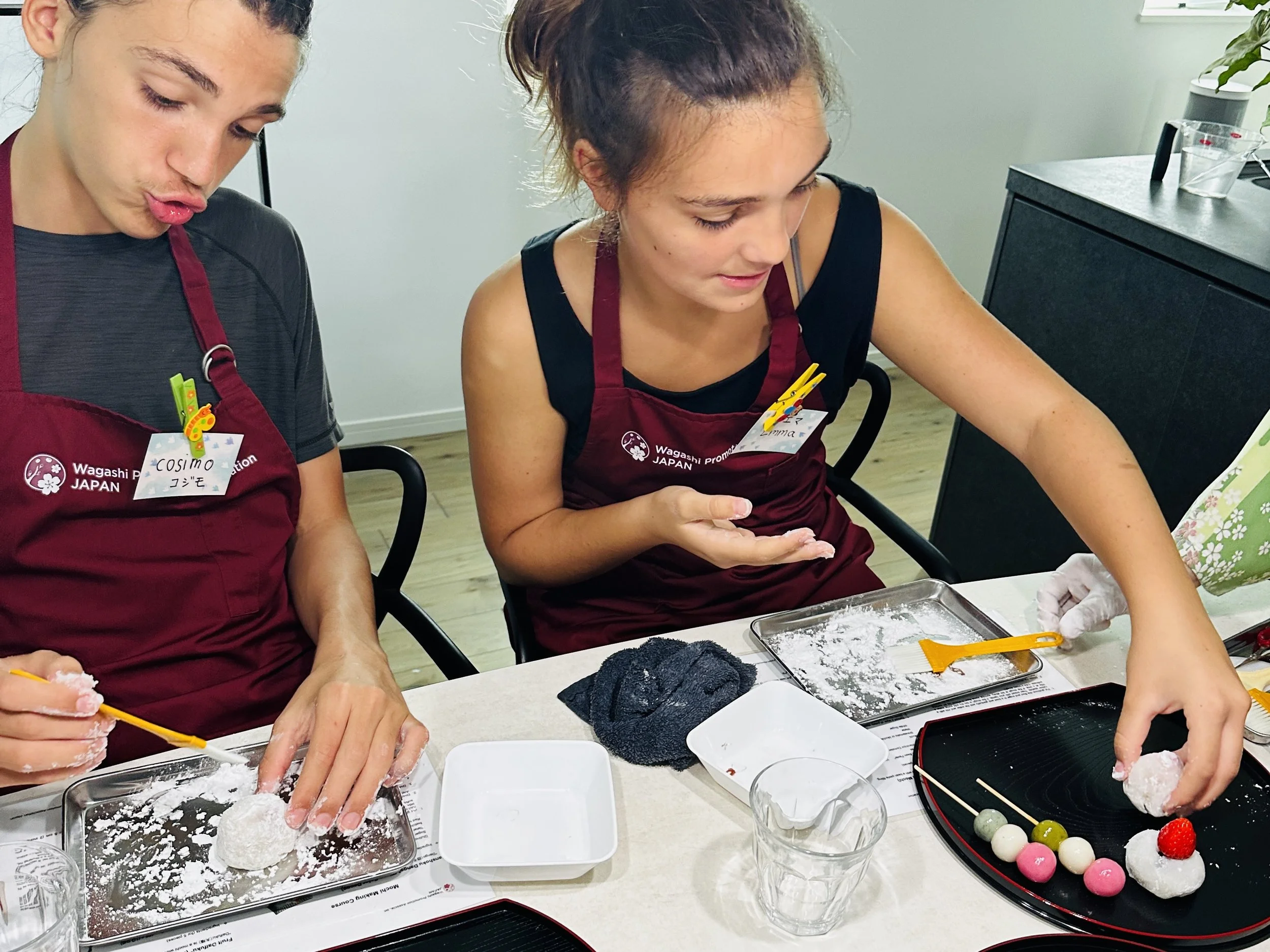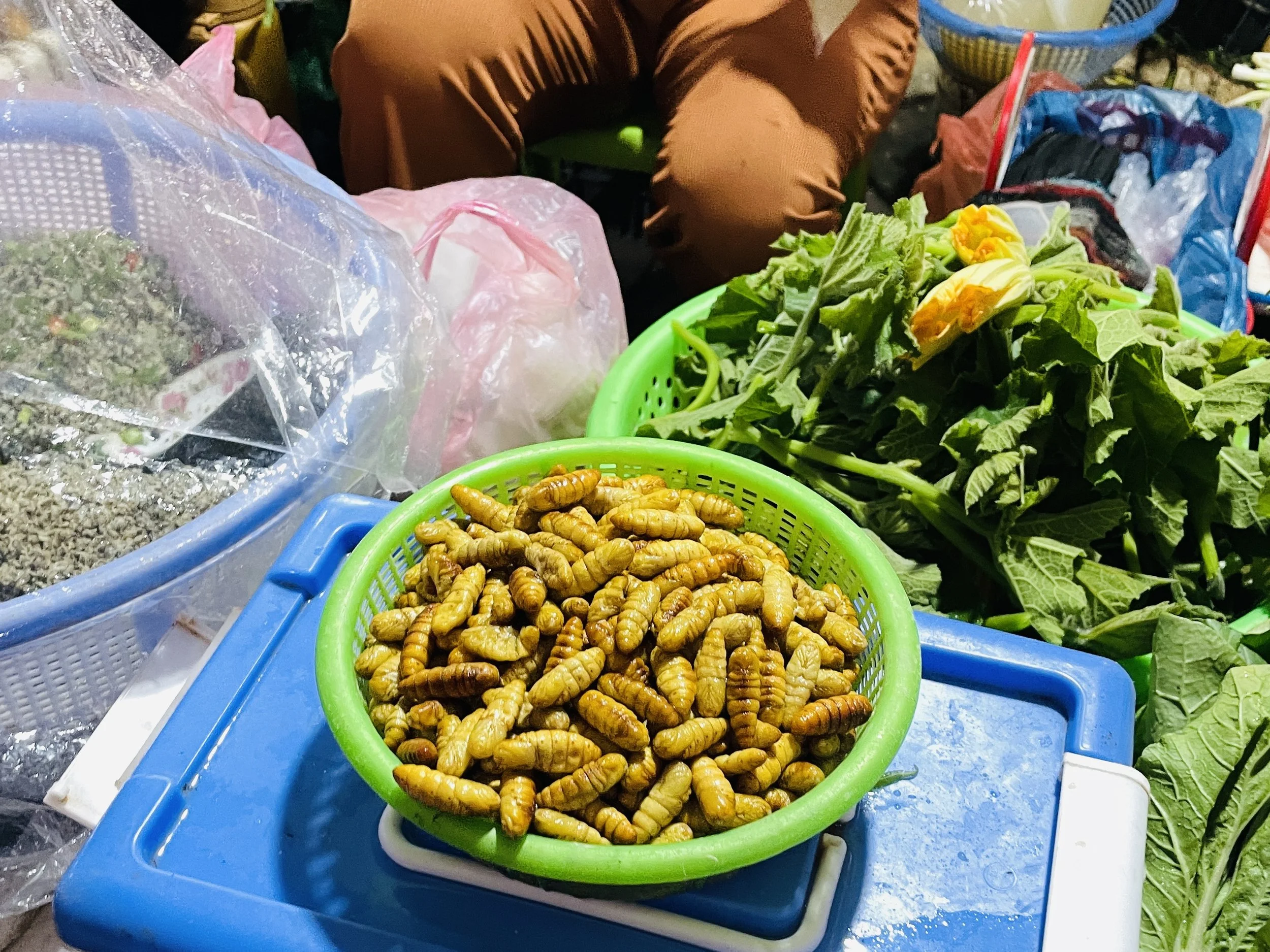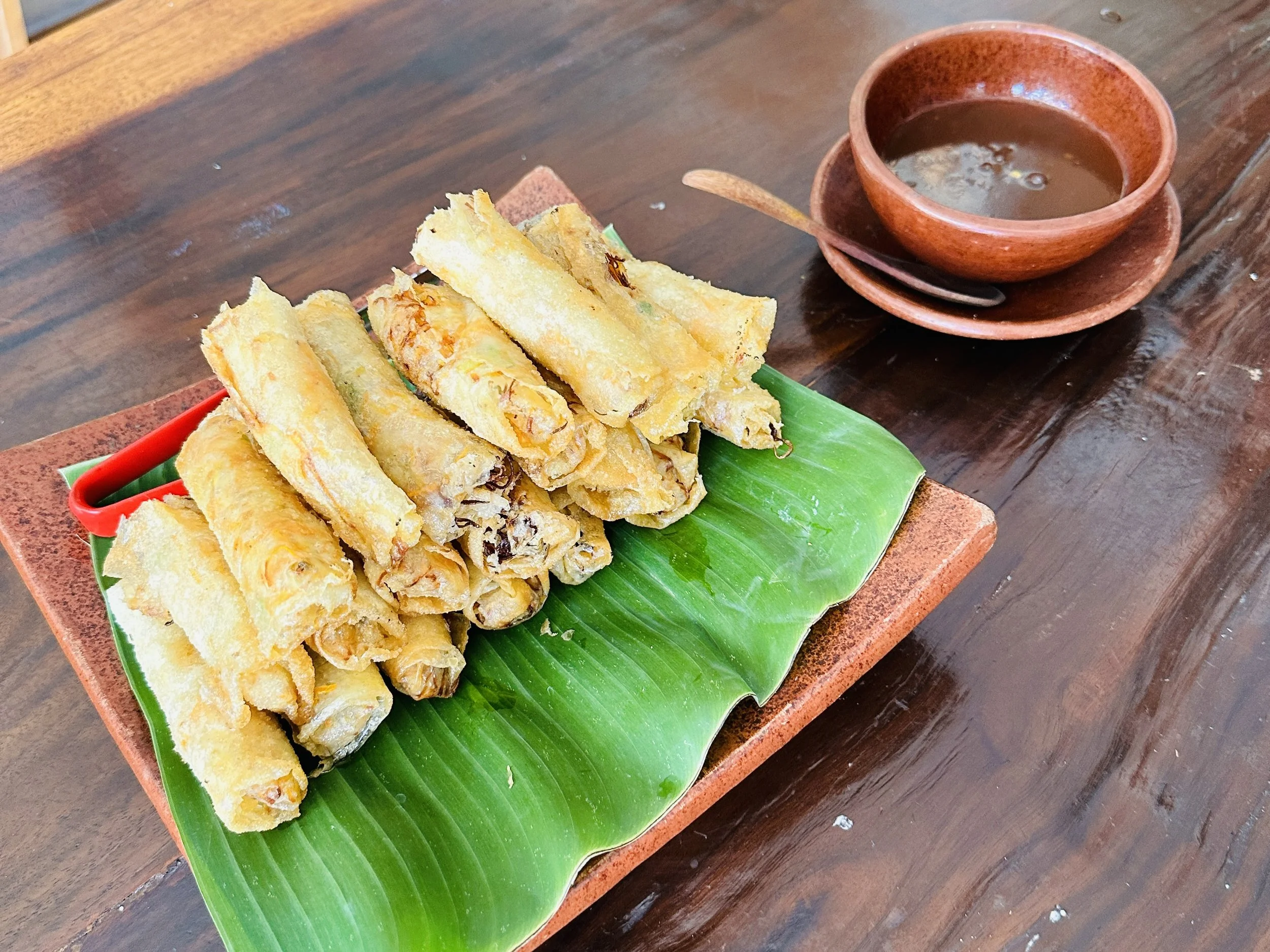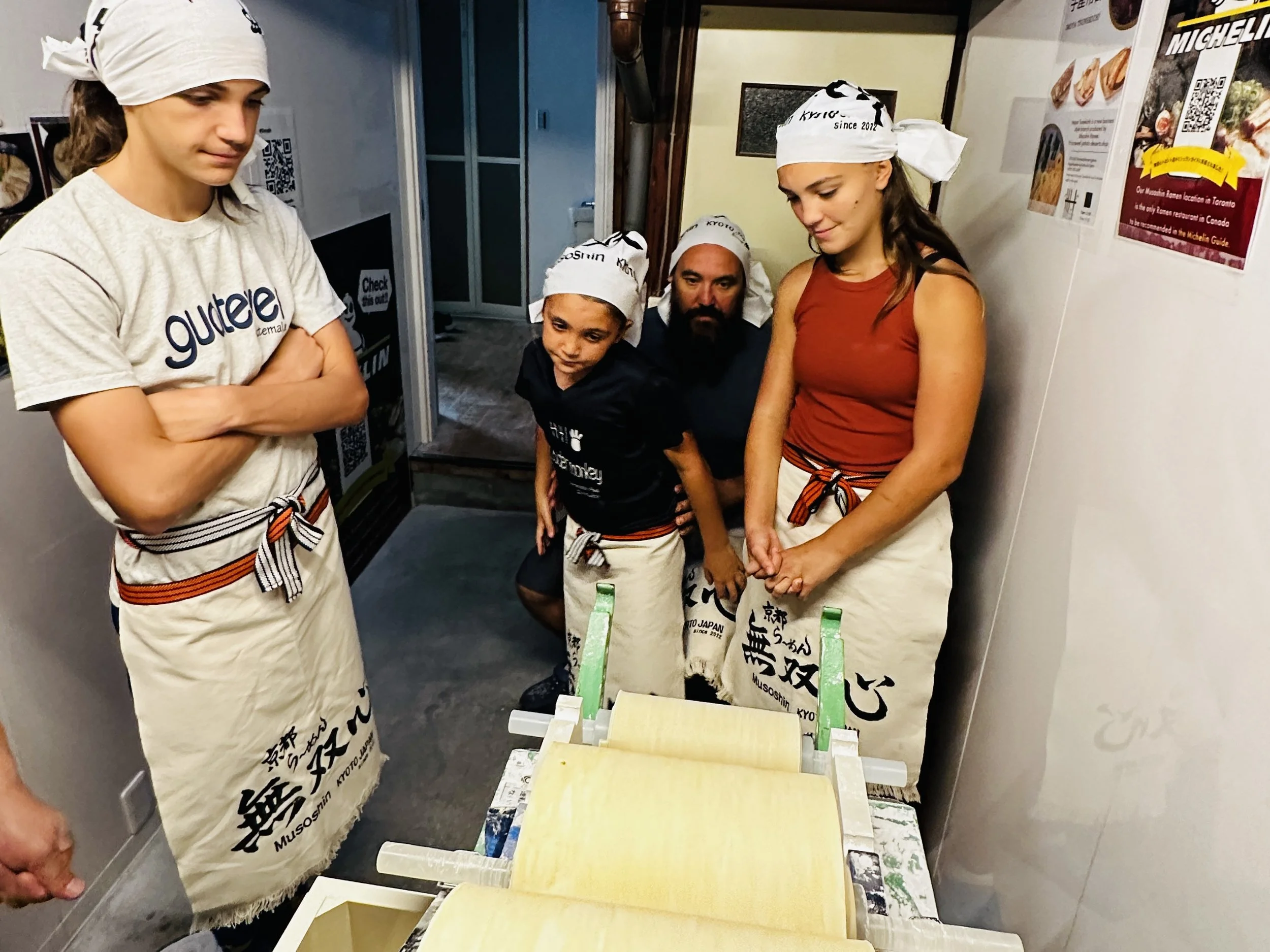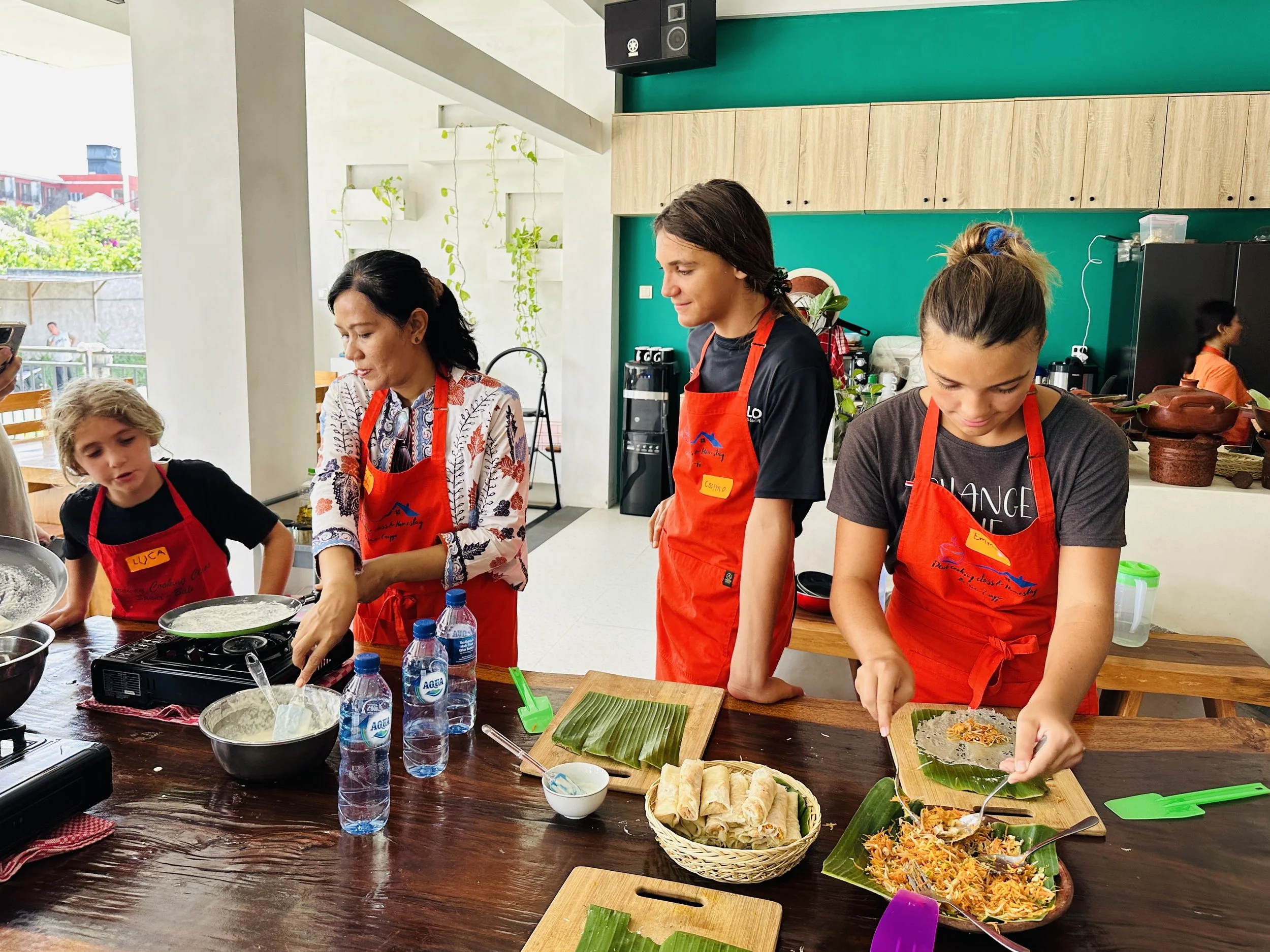Cooking Classes Around the World: Why They’re Our Favorite Family Activity
Some of our best family travel memories weren’t made at famous landmarks but in kitchens around the world. From rolling sushi in Japan to pounding spices in Cambodia, cooking classes have become our favorite way to learn, laugh, and connect as a family. Here’s why and how these hands-on experiences have turned into one of the most rewarding parts of our travels.
When you travel as a family, some of the most lasting memories come from the unexpected. For us, it hasn’t always been the iconic landmarks or the big-ticket attractions that stood out. Instead, some of our fondest memories have been created in kitchens around the world.
We never planned to make cooking classes a family tradition, but they gradually became an integral part of our journeys.
The first time we tried one, it was simply a fun way to fill an afternoon. But it turned into so much more, a chance to taste, learn, laugh, and bond. Before long, booking a cooking class became something we looked forward to almost as much as hiking to ruins, visiting temples, or exploring a new city.
Why? Because food is universal. It connects people across cultures, languages, and borders. The smell of garlic sizzling in oil, the rhythm of kneading dough, and the joy of sharing a meal at the end are experiences that feel familiar no matter where you are in the world. And when you learn to cook a dish from locals, you aren’t just following a recipe. You’re stepping into their culture, their family traditions, and their way of life.
Even now, certain flavors instantly carry us back to a specific time and place. The taste of lemongrass brings us to a Balinese kitchen, the aroma of freshly baked bread recalls a Parisian bakery, and a bowl of ramen transports us to Japan. Cooking classes have given us stories, skills, and family inside jokes that no souvenir could ever replace.
Why Cooking Classes Work So Well for Families
Cooking classes are the perfect family activity for so many reasons:
Hands-on learning: Children learn best by doing, and cooking is certainly a hands-on activity. Whether it’s kneading dough, stirring a bubbling pot, rolling sushi, or patting out tortillas, they get to be part of the process from start to finish. We’ve found that our children stay more engaged during cooking classes than almost any other type of tour or activity. There’s no long lecture, no sitting still, just action, creativity, and delicious rewards.
Cultural immersion: Every dish has a story to tell. Cooking with locals gives us insights into traditions and values that we’d never learn from a guidebook. In Bhutan, chilies aren’t just a spice; they’re a vegetable eaten daily. In Cambodia, banana leaves are used as cooking vessels. In Japan, rice preparation is an art form. These lessons go beyond the kitchen; they reveal the heart of a culture.
Memorable bonding: Cooking together sparks laughter and teamwork. We’ve had moments when spring rolls turned out completely different from what was intended, dumplings came out in funny shapes, and the kids bickered over who stirred the veggies best. These silly little moments become the stories we retell long after the trip. Cooking classes transform a group of travelers into a family team, even if that team argues over who gets to stir the pot!
Confidence-building: Something magical happens when kids cook a dish themselves. Suddenly, they’re eager to try foods they might otherwise refuse. Luca, our pickiest eater, happily devoured mochi in Japan after making it himself. When children take ownership of food, they become braver eaters and more open-minded travelers.
Some Cooking Classes We’ve Joined
We never set out to make cooking classes a family tradition, but after the first few, they naturally began weaving themselves into our travels. Each kitchen has become a window into a new culture, and every dish has added another layer to our family’s story.
To date, we’ve traveled to 61 countries and joined more than 30 cooking classes, each one teaching us something new about food, people, and ourselves. Here are some of the experiences that stand out most vividly along the way.
🍜 Japan – The Art of Ramen, the Precision of Sushi, and the Sweetness of Mochi
In Japan, we had the broadest range of culinary experiences. We joined classes on ramen noodles, sushi, and even our favorite dessert: mochi. Each one left us with new skills and a deeper appreciation for the foods we already loved, which now feel even more woven into our family’s story.
Ramen was all about patience. We attended a class tucked away in the back of a famous local restaurant in Kyoto. While much of the process involved specialized machinery, we still got hands-on experience with adding the flour, helping with the kneading, and collecting the noodles as they came out, ensuring each bundle was grouped to the exact right weight. Afterwards, we sat down at the restaurant and enjoyed what turned out to be the best ramen we’d ever had.
We also visited the Cup Noodles Museum, where we explored the fascinating history of instant ramen. We also attended a special class on how the noodles are prepared. At the end of the whole process, the kids loved designing their own custom cup, filling it with noodles and ingredients, and sealing it to take home. It was the perfect blend of education, creativity, and fun, making us appreciate ramen in a whole new way.
Sushi, on the other hand, required precision and focus. From learning how to handle rice properly (neither too tight nor too loose) to slicing vegetables and fish into perfect pieces, the kids quickly realized that sushi is as much about art as it is about food. Our teacher explained how sushi reflects balance and respect for ingredients, and it stuck with all of us. Food doesn’t need to be complicated to be meaningful.
Mochi was pure joy. It’s always been one of our favorite desserts, so we knew we had to learn how to make it. We joined a private class in a kind woman’s home, where she guided us through the process step by step, weaving in the history behind this traditional sweet. It was absolutely delightful, not only for the experience itself but also for tasting the best mochi we’d ever had. Even Luca, usually our pickiest eater, made his own and happily devoured them all!
🥔 Peru – From Market to Table
One of our most memorable classes in Peru began not in the kitchen but in the vibrant local market. With our chef as a guide, we wandered through stalls overflowing with colorful potatoes, exotic fruits like lucuma and chirimoya, and bundles of fresh herbs we’d never seen before. The kids loved asking endless questions about the ingredients that locals use on a daily basis.
Once our bags were full, we headed back to the kitchen, where the real magic began. Together, we prepared fresh ceviche with fish and a fragrant lomo saltado, quickly stirred to capture the perfect balance of flavors. To top it all off, we even learned how to make the traditional pisco sour, with a non-alcoholic version for the kids, of course!
Cooking straight from the market made us feel connected not only to Peruvian cuisine but also to the rhythm of daily life. Every bite carried us back to those lively stalls where our journey began.
🥟 Cambodia – From Market to Kitchen
In Cambodia, our cooking class also began in the heart of the market. We wandered past rows of exotic fruits, bundles of morning glory stacked high, and stalls where locals were busily preparing food for their own lunches. It was a vibrant glimpse into daily life as we picked out the fresh ingredients we would need.
Back at the cooking school, we learned to prepare amok, a fragrant curry traditionally steamed in banana leaves. Everyone took turns grinding spices with a heavy mortar and pestle, giggling as the powerful aromas made our eyes water. Folding the banana leaves into little bowls for steaming felt like a mix of arts and crafts with a delicious reward at the end.
When we finally sat down to taste our amok, the flavors were spicy yet rich, layered, and new to us. The kids were so proud of creating something so different from what they usually eat. It was a reminder of how food can gently push boundaries while still being fun and delicious.
🌴🍲 Bali – A Feast of Flavors
Bali’s cuisine is as vibrant as its landscapes, and our cooking class captured that perfectly. We began in the bustling morning market, wandering past stalls stacked with chili peppers, fragrant lemongrass, baskets of turmeric and galangal, and tropical fruits glowing in every shade of orange and yellow. The kids were wide-eyed as they compared unusual vegetables, tried samples from friendly vendors, and watched locals bargaining with ease.
Back in the kitchen, we rolled up our sleeves and prepared a complete Balinese feast. First came Lupis Bali, sticky rice cakes drizzled with sweet palm sugar syrup and sprinkled with coconut. Then nasi kuning, a fragrant yellow rice cooked with turmeric and coconut milk, perfumed the air as it steamed. We also made kering tempe, a crunchy, savory snack, and chicken serundeng, simmered chicken coated in toasted coconut, which combined crispy and juicy in the best way. To top it off, there were lumpia, crispy spring rolls, and the fiery sambal that Balinese meals are never complete without.
By the time we sat down to eat, the table looked like a banquet. Every dish told part of the island’s story, blending spices, textures, and flavors in ways that felt celebratory. Cooking in Bali wasn’t just about recipes; it was about sharing the spirit of togetherness that runs so deeply through Balinese culture.
🌽 Guatemala – Cooking in Antigua
In the cobblestoned streets of Antigua, food felt like history served on a plate. Our cooking class began with an introduction to Guatemala’s most iconic dishes, and each step pulled us deeper into the country’s traditions.
We started with pepian, a rich, earthy stew made with roasted spices, seeds, and vegetables blended into a thick sauce, then simmered with meat and potatoes. The flavors were bold yet comforting, and our kids were fascinated by how so many different spices could come together so harmoniously. To balance it, we made a radish salad, simple, fresh, and the perfect crunchy contrast to the heavier stew.
Next, we prepared rellenitos, one of the most surprising and delicious discoveries for us. These sweet plantains, filled with beans and lightly fried before being dusted with sugar, struck the perfect balance between savory and sweet. Watching the kids tentatively take their first bites and then immediately ask for seconds was one of those moments we’ll never forget.
We also stirred atol blanco, a warm, slightly sweet corn drink that has been enjoyed for generations. Finally, we tried our hands at hand-patting tortillas, a process that looks far easier than it is! The rhythm of slapping and shaping the dough was tricky at first, but soon everyone was laughing and comparing their slightly uneven results.
By the time we sat down to eat, the table was covered in a rich tapestry of color, scent, and texture. It wasn’t just about enjoying the food; it was about the pride of creating something together and the more profound appreciation for Guatemalan traditions that cooking gave us.
🥟 Mongolia – Dumplings & Noodles
Just days after arriving, we joined a class where we learned how the country’s traditional dishes rely on hearty, simple ingredients like flour, meat, and root vegetables, designed to fuel people for life in a demanding climate.
Our first dish was tsuivan, a noodle stir-fry that begins with making the noodles from scratch. Rolling, cutting, and stretching the dough was hands-on work that immediately pulled everyone in. Once the noodles were ready, we tossed them with meat, onions, and cabbage into a sizzling wok. The result was warm, filling, and comforting food that clearly matched the needs of Mongolian life.
Then came dumplings, which quickly became a family favorite. We learned to make two kinds: steamed and fried. The kids competed over who could make the most “perfect” dumpling, though in truth, some of ours looked hilariously lopsided. But no one cared, because when they came out of the steamer and frying pan, they all tasted incredible. Juicy, savory, and deeply satisfying, these dumplings felt like the ultimate comfort food.
What struck us most was the communal aspect of it all. Dumplings in Mongolia aren’t just food; they’re a way of gathering people together, with everyone pitching in to roll, fold, and cook. Sharing that meal, we felt as though we’d been given a glimpse into the heart of Mongolian hospitality and the strength of a culture built on resilience and togetherness.
🌍 And Beyond…
We’ve also cooked in other corners of the world, rolling pasta in Italy, shaping buttery croissants in France, pounding chilies into fiery ema datshi in Bhutan, and folding fresh spring rolls in Vietnam, and so many more. Each class gave us more than just recipes; they offered small but meaningful glimpses into the traditions and daily life of each culture.
Tips for Booking Cooking Classes with Kids
Over time, we’ve picked up some strategies for making cooking classes a success with kids:
Choose the right class for your child's age. Private or small-group classes are usually best, as they allow kids to spend more hands-on time.
Ask if it’s truly interactive. Some classes are more like demonstrations; kids enjoy it more when they’re rolling, stirring, or shaping food themselves.
Check the menu in advance. Ensure there are roles your kids can play, even if it’s as simple as decorating or stirring.
Prepare them before you go. Watching a video or reading about the dish makes kids more excited.
Embrace the mess. Cooking with kids is never neat, and that’s part of the fun.
When possible, include a market visit. Some of our most memorable lessons came not from the kitchen but from walking through bustling stalls. We’ve discovered fruits we’d never seen before, learned the local names for herbs and spices, and even tasted street snacks we wouldn’t have known to try. Markets bring the culture alive and give kids a chance to see where food truly begins.
Cooking Classes as Worldschooling
For our family, cooking classes aren’t just fun, they’re part of our worldschooling journey. Each one blends multiple areas of learning:
Geography – Where do the ingredients come from? How does climate shape food?
History – What stories are tied to this dish? Was it consumed by farmers, royals, or the general public?
Science – Why does dough rise? How do spices change when heated?
Math – Measuring, dividing recipes, and adjusting portions.
Language – Picking up food words in the local language.
Cooking has become one of the richest classrooms we’ve found on the road.
Final Thoughts
When we look back on our travels, the memories that bring us the most joy often come from the kitchens. Cooking classes have given us much more than recipes; they’ve given us moments of laughter, teamwork, and connection. They’ve shown us how families eat, celebrate, and live in different corners of the world.
So if you’re planning a family trip, consider signing up for a cooking class. Don’t just eat the local food, learn to make it. You’ll leave with a full belly, a new skill, and memories that will stay with you long after the suitcases are unpacked. And if you’d love some guidance in finding the perfect family-friendly classes or other hands-on cultural experiences, I’d be happy to help you weave them into your travels.
Wishing you all Happy travels!



